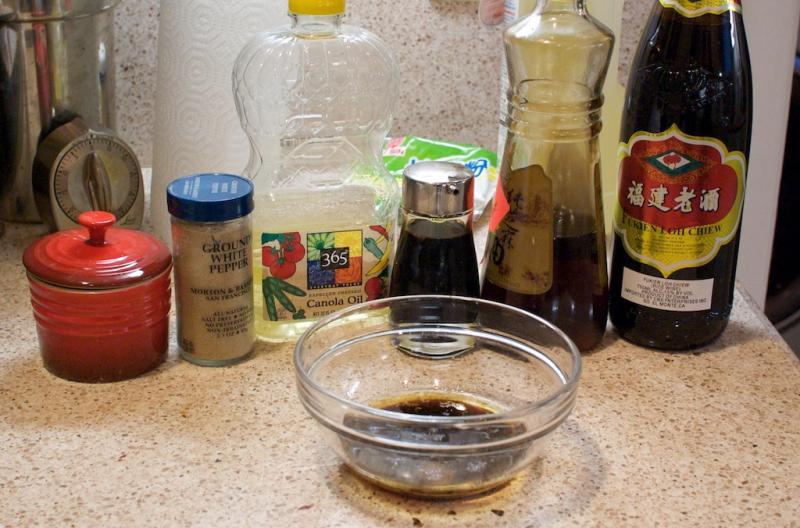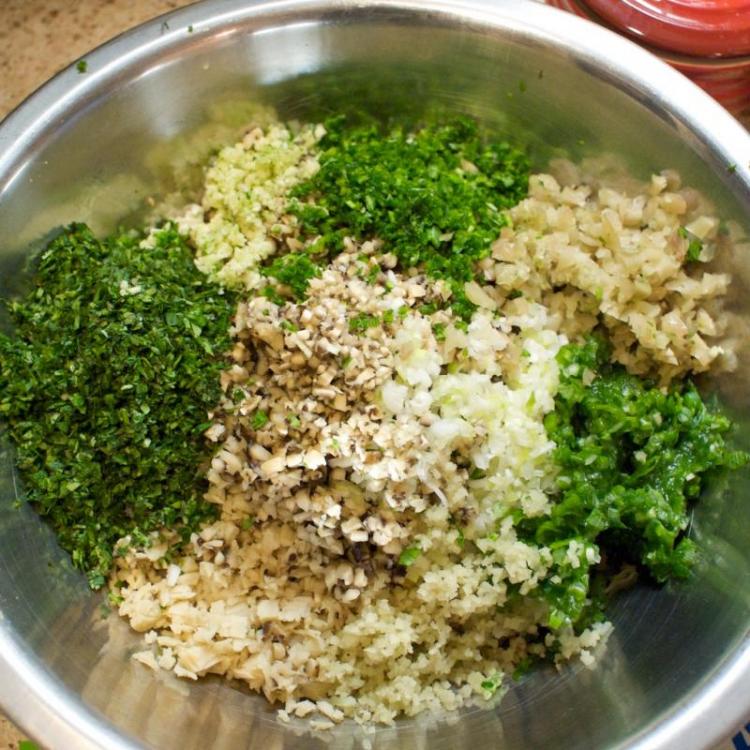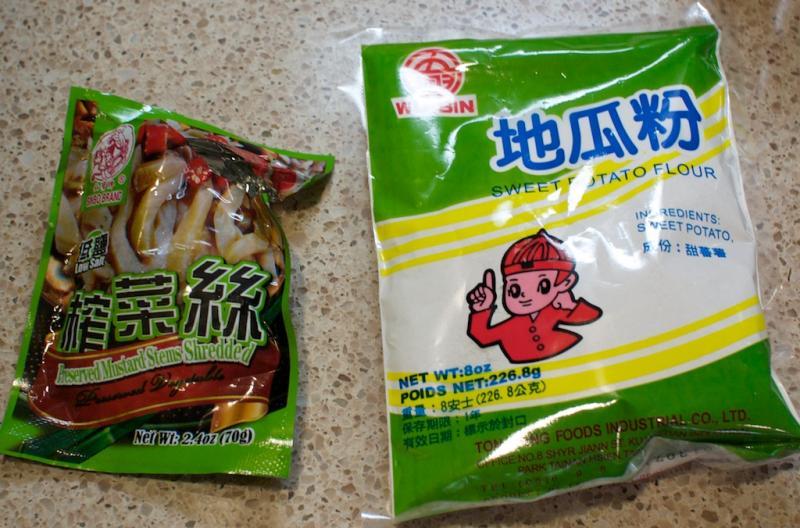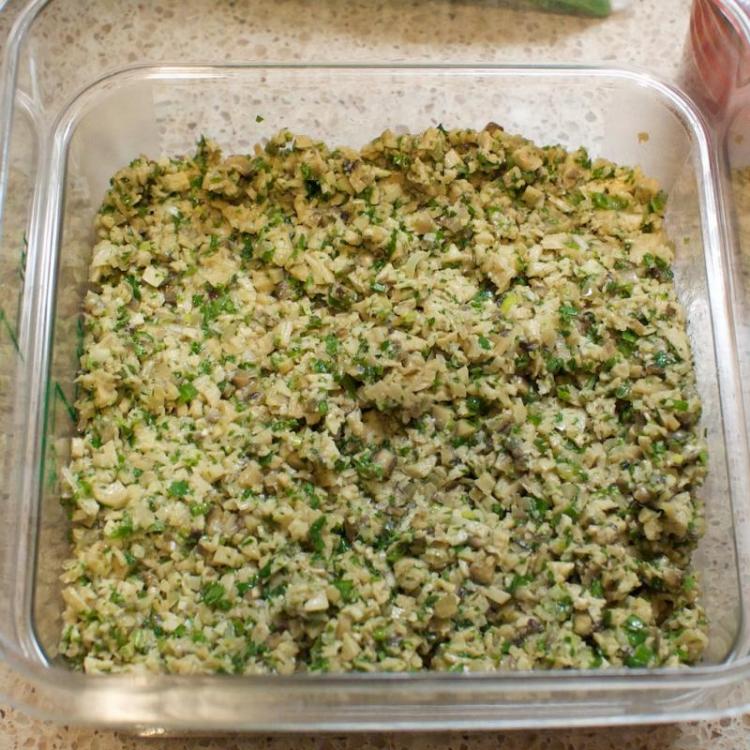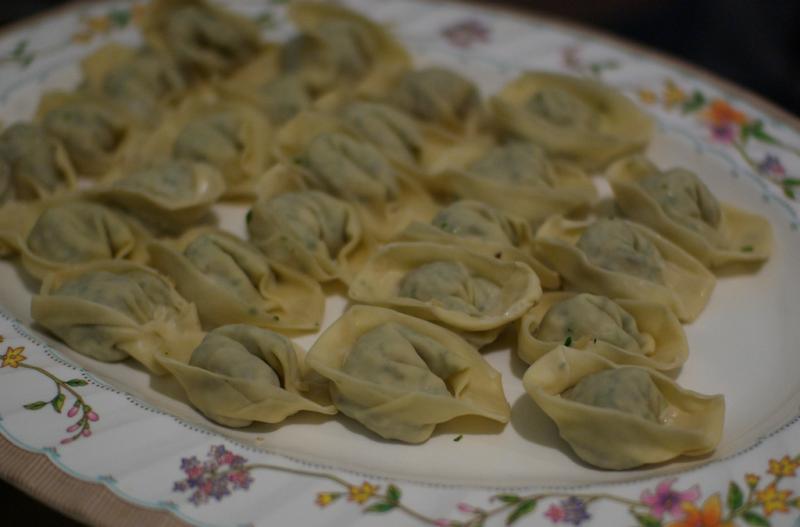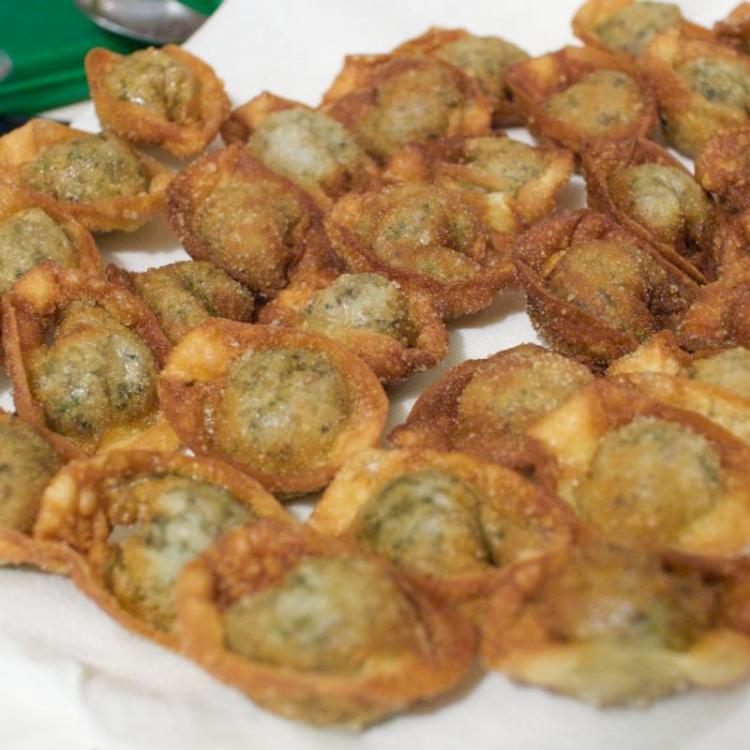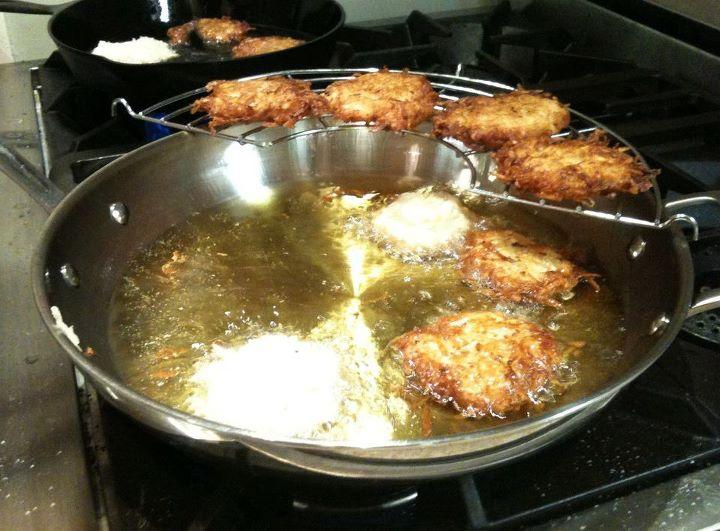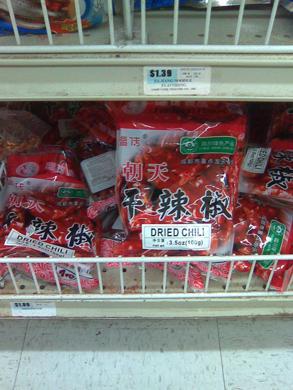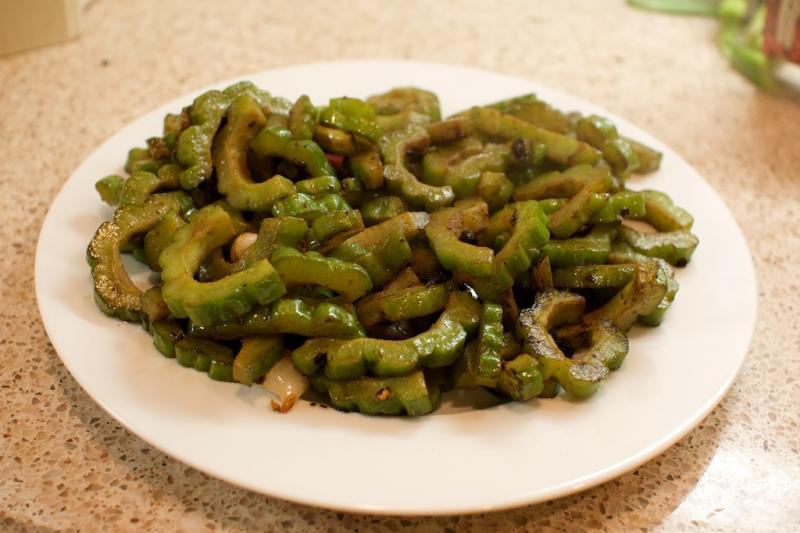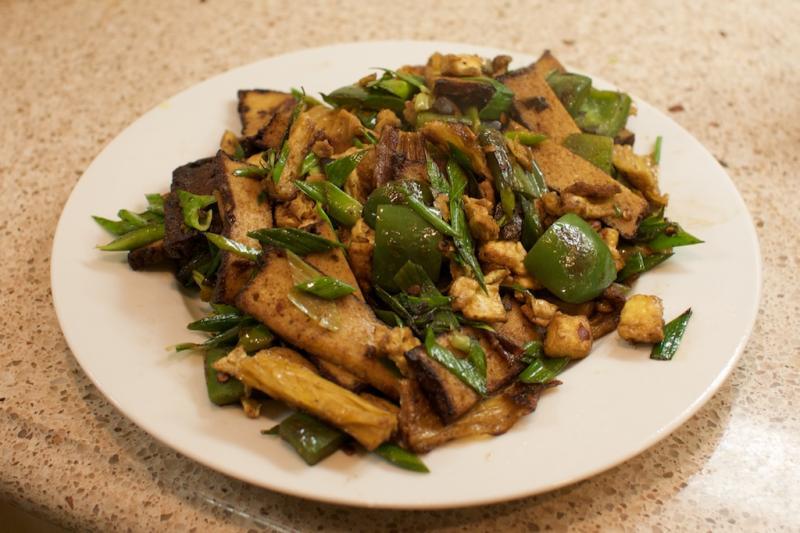
Will
participating member-
Posts
461 -
Joined
-
Last visited
Content Type
Profiles
Forums
Store
Help Articles
Everything posted by Will
-
In honor of New Years Eve, I made a vegetarian adaption of "New Year Money Bags" from Cooking from China's Fujian Province by Jacqueline M. Newman. They're supposed to be shaped like golden ingots more than money bags (originally, I imagined they'd be purse shaped), so basically it's folded like a normal wonton, but squared off more, and the edges are folded down. I used minced wheat gluten and soybean based vegetarian "intestine" instead of the pork, and a bit of preserved mustard stem and some extra oil to replace the extra fat and salt from the omitted shrimp. Came out pretty well, especially for a first try. New Year Money Bags Adapted from "Cooking From China's Fujian Province" by Jacqueline M. Newman [note: the wording, as well as some of the ingredients, have changed, so hopefully posting this doesn't run afoul of forum policies]. 8 dried Chinese style shiitake mushrooms, soaked stems down, stems removed. 8 oz wheat gluten or other meat substitute (I used 'mian chang' -- wheat gluten intestine, and mine was made with some soy as well). 4 scallions, green and white parts 4 cloves garlic, or 2 cloves of garlic and 2 individual strands of fresh garlic stalk (suanmiao / "Taiwan leek") if available 4 slices fresh ginger, peeled 1/2 C fresh cilantro, with some stems, washed and dried salted mustard stem or other salted Chinese vegetable 4 tsp regular soy sauce 4 tsp sesame oil 2 tsp vegetable oil 4 tsp Fujian / Fukien rice wine (probably can substitute Shaoxing if not available) pinch or two of salt 1/8 tsp white pepper pinch vegetarian boullion or seasoning (optional) 3 Tbsp sweet-potato flour (note: this is not the same as potato flour / potato starch, though you could probably sub potato starch or cornstarch) 1 package square wonton wrappers (eggless if you're trying to make vegan) 1 egg, beaten, ener-g egg replacer or corn / potato starch mixed with water vegetable oil, for frying. Wring out the wheat gluten and shitakes so that they'll soak up as much of the liquids as possible. Finely mince the mushrooms, wheat gluten, scallions, garlic / fresh garlic stalks, ginger, and cilantro. Chop the salted vegetable a little more coarsely. Mix together. Mix the wet ingredients along with the salt, white pepper, and vegetarian boullion or seasoning. Add the sweet-potato flour and wet ingredients to the mushroom / wheat gluten mixture, and combine. Let set for a little for the liquid ingredients to get absorbed. The recipe's directions for folding the pouches are pretty unhelpful. I mostly just followed my father-in-law, but this is one of those times where a picture / diagram is worth 1000 words. http://www.thegourmetforager.com/2011/04/fair-dinkum-barbequed-prawn-dumplings/. Basically like a normal wonton, but you try not to leave much space in the middle, and you push the points down and square off the ends to try and form roughly an "ingot" shape. Use the egg or water / starch slurry to seal. Deep-fry in vegetable oil until golden and crispy, and let drain on a rack. Serve with any kind of dipping sauce (we had a simple sauce with lemon, soy sauce, garlic, ginger, and sugar, but I bet a thick sweet / sour type sauce or Chinese mustard would be good too).
-
We keep most of our weeknight dinners in a Google calendar (to keep track of who's making what on their night to cook). So sometimes if I'm not feeling inspired, I'll run back through a few months back of what we ate, and try to see if it either inspires me to think up something new, or at least reminds me of some boring standby that I can make.
-
I think that Alice Waters's The Art of Simple Food might be a good choice. It's got a good section about ingredients and equipment, how to cut things, etc., and the recipes are not dumbed down but many still should be manageable for beginners. I have the vegetarian version of How to Cook Everything; while I appreciate Bittman's approach, and all the basic information he provides, and his encouragement to experiment, I do think the sheer volume of recipes and endless variations might be intimidating to some as a first cookbook. Also worth considering how interested / motivated the recipient is, and what types of things they like to eat.
-
If you'll have sparkling wine around also, you could make French 75s. It's normally made with gin or cognac - I've usually seen it with gin, but I think cognac is also traditional; the brandy you have should be fine. I'm not sure what you call the same thing made with vodka in place of gin. Worth seeking out some fancy cocktail cherries for garnish if you have a chance, or a lemon twist would work. I think it would be a good choice for New Years Eve. Couple recipe options here: http://savoycocktails.appspot.com/show?cocktail=ag5zYXZveWNvY2t0YWlsc3IPCxIIQ29ja3RhaWwYwAoM http://cocktaildb.com/recipe_detail?id=3082 I think you would want to either use powdered sugar, or make simple syrup. Nthing Sidecars. I like them up rather than over ice. The 1.5 - 1 - .5 ratio works pretty well for me most of the time, but you'll want to taste and adjust as necessary. I find that ungarnished sidecars look kind of ugly, maybe because of all the brown color from the brandy; if you want to make it look nicer, I'd suggest: * Rim the glass with sugar * Express a swath of citrus peel (a veg peeler will usually do an Ok job at doing this, or use a paring knife) over the finished drink; optionally you can also garnish with the citrus peel, or with a citrus twist. I'd use lemon, but orange would also make some sense (since there's orange liquor in the drink). * Pre-chill your cocktail glasses in the freezer. Also, use dry, fresh ice. If you buy some rye or bourbon, even a cheap or mid-level one, and some sweet vermouth, maybe some kind of pastis or absinthe, you will open up a range of other possibilities (Old Fashioned, Manhattan, Hot Toddy, Gold Rush, etc.) If you've got some not-too-expensive red wine, you could also consider making some glogg, or another kind of mulled wine, which you could optionally fortify with some brandy or some of the orange liqueur. http://www.nytimes.com/2011/12/11/magazine/glogg-before-nog.html
-
I don't know if it's resting on a rack rather than on paper towels / bags that's making some of the difference, but I used about 50-60% rice bran oil (said to give crispier results for tempura), and my latkes this year came out crispier than usual. Mine are pretty standard - potato, onion, matzoh meal, kosher salt, pepper. I grate the potatoes by hand on a box grater no matter how many I'm making, wring out the potatoes as well as I can, and since I usually don't use egg, I add back the potato starch solids to the mix. I shallow fry them in a fair amount of oil. I've done beet and sunchoke pancakes before - sunchoke ones are great, but the after-effects not as great.
-
Why the Hell are there Soap Suds on the Washed Dishes?!
Will replied to a topic in Food Traditions & Culture
Sure, but what's the benefit of drying with a towel? It's more work. I only use a towel when something is too large to fit in the dish draining rack or where I'm really worried about appearance; most of the time, I air-dry stuff upside-down in the drying rack, and it looks fine. -
http://en.wikipedia.org/wiki/Shaoxing_wine#Producers has a list of some producers, most of whom seem to produce drinking grade stuff. It mentions Gǔ Yuè Lóng Shān (古越龍山) Dì Jù Táng (帝聚堂) Kuai ji Shan (doesn't specify) Tǔ Shào Jiǔ (土绍酒) I don't know where you live, but I'm not sure how much luck you'll have finding an online source that sells drinking grade Shaoxing wine to the US / Canada market. The demand is low, and probably concentrated mostly in areas with a large Asian population. Shào xīng is the standard Hanyu pinyin for 绍兴 (pronounced in Mandarin with a falling tone and then a high flat tone, roughly 'shao sheeng' (with the tongue curled back for the first 'sh') or 'sao sheeng' (most Southern Chinese and Taiwanese don't pronounce the sh / zh / ch sounds in the standard way)), however, because it's been sold in the West for so long, many other romanizations are common. Just to make sure, have you looked in other parts of your local Asian market besides where the cooking wine is sold, and are there any bigger / better Asian markets within driving distance? You mention the state liquor stores - are grocery stores even allowed to sell non-cooking alcohol where you live?
-
Why the Hell are there Soap Suds on the Washed Dishes?!
Will replied to a topic in Food Traditions & Culture
I had a German roommate who did this; she insisted that the soap slides off and it's not a problem. I do think this approach is more common in Europe. Personally, I am really obsessive about washing all the soap off -- even if a little soap is left on the back of something, I'll take it back and rinse it again. -
Today, Sea Dyke yellow tin lao cong shui xian (Wuyi yancha), then 80s Xiaguan "Traditional Characters" pu'er.
-
I think it would sound a bit pretentious for an American to pronounce "scone" with a British accent, though. I always say it with the "oh" vowel.
-
I have done this before, and have had the same worries as you. I don't have an answer, but I will say that sometimes I use coffee filters as an alternative.
-
How is Mascarpone not on this list?
-
Most drinks won't call for much of it (it's a pretty strong flavor), and it should last for a long time. I agree that buying the smaller bottles may make some sense if available.
-
Niki Nakayama of N/Naka in LA is a trained sushi chef, and ran a sushi place before opening her current place (which does modern kaiseki style cuisine; the dinners do include a sushi course, though). http://www.n-naka.com/about/chef/
-
I haven't been to Alinea specifically, but usually, the portion sizes are such that, even with many courses, you leave comfortable, but not stuffed. The posts I can find about Alinea seem to suggest that this is the case here. I wouldn't suggest skipping lunch - just have a light lunch, at least 5 hours before your reservations. You want to be hungry enough that dinner seems appetizing, but not famished. One thing to consider if you're worried about drinking too much, is to buy a bottle of wine to share, or wine by the glass, rather than doing the wine pairings. For me, seeing how a wine changes across the various courses is sometimes more interesting than having a wine specifically paired with each course.
-
Latkes. Please help me not be a cultural idiot.
Will replied to a topic in Food Traditions & Culture
I use the same method as above -- wring the potatoes out over a bowl, let it sit for a bit; then pour off the liquid. The (surprisingly) dense white layer on the bottom of the bowl is potato starch. Scrape this off, and add it in with the batter. I'm veganish, so I usually make my latkes without egg, and this works pretty well. I'm partial to this recipe (the eggs can be omitted if you use the potato starch). http://www.chow.com/recipes/10812-potato-latkes I'd been making latkes since I was a little kid using a very similar recipe, but I never got the memo about squeezing the potatoes (my family's not Jewish) or using matzoh meal instead of flour. I think those two little changes have really improved my latke game. Applesauce and sour cream are definitely good accompaniments; if you want a vegan option for the sour cream (not sure if the kids will even like it), you could get some "Vegan Gourmet" brand sour cream (or the Tofutti sour cream if that's not available). Just don't serve ketchup and you'll be Ok! Haroset is mostly associated with Passover. -
I freeze muffins all the time, and I think it works pretty well. If you slightly under-bake them initially, you can let them brown a little more when they re-heat. I usually reheat them for 20-30 minutes at 300-350. The pumpkin bread will be good in the fridge for about a week or so, but you might want to freeze if it's going to be longer than that (I think the texture actually improves a little with refrigeration for quickbreads, but not as much for muffins).
-
I have both. Originally, I definitely found Sitram Catering to be a better value. However, the price of Sitram's Catering series has gone up quite a bit since I bought most of my pieces (probably because of the great increases in the price of copper), and All-Clad is frequently available at discounted prices. There are a few applications where I find that having a disk bottom, especially one that doesn't go to the edge of the pan, is a minor limitation, and even with stockpots or saucepans, I have noticed a slight benefit (in terms of cooking evenness and efficiency) to fully clad cookware. While I personally really like the utilitarian / commercial cookware look and feel of Sitram, I think a lot of home cooks, especially those who don't use a side towel or pot-holder to grab their pots and pans, would probably not find the Sitram handles comfortable. They might also find the lack of helper handles on some items a problem. I know lots of people hate All-Clad's handles too, but they stay cool better than the handles on most stainless cookware, and they don't have sharp edges. And, they look shiny, which is not a big concern for me, but might be for others. Another big difference between the two is that All-Clad has riveted handles, whereas Sitram has welded ones. Some advantages and drawbacks to each. While I've never experienced problems with the welded handles on my Sitram pieces (they seem built to handle a lot of abuse), I've heard one or two anecdotal complaints about them breaking. On the other hand, the rivets on All-Clad (which I have to admit do look nice) make them a bit harder to clean. I have a "mix and match" approach... as far as pots / pans, I've got All-Clad, Sitram, Vollrath, CIA, and De Buyer, among others. I use them all, and while I see occasional benefits of one or the other for a particular purpose, I use them all. Price aside, there's nothing that I especially dislike about All-Clad. For the most part, it is durable, comfortable to hold, distributes heat well (more so with the D5 series), looks nice, solid but still usually light enough to toss things in comfortably, made in the US if you're into that kind of thing, and a good warranty. The older All-Clad pieces don't have rolled edges, but most of the new ones do.
-
I don't doubt that an 8 qt All-Clad stockpot is pretty nice, but I'd question the utility of buying one (at least their regular fully clad one), vs., say, a cheaper tri-ply stockpot like Tramontina or Vollrath Tribute, or even a heavy disk-bottom one with a bottom that extends to the edge. If I were going to spend $300 on one or two pieces of expensive cookware for someone, whether All-Clad or another brand, I'd focus on the pieces likely to benefit the most from even heating and more responsiveness -- I would be thinking about sauciéres, skillets, and straight side sauté pans. Also, while I don't see a 3 qt D5 sauciére right now, and the standard 3-ply doesn't have the rolled lip AFAICT, I think the copper-core is not really worth the extra money (maybe for a gift) unless it's heavily discounted; I'll also say that both D5 and copper-core are noticeably heavier than the standard All-Clad stuff.
-
I can get dried (and powdered) chaotianjiao (facing heaven) chilis here in LA a lot of the time, at least the bag claims they are. After drying, the shape is not so very different from Tianjin style peppers, but the top is a little bit wider, and the texture a bit different. I think the heat and flavor are both a little bit higher than standard peppers, but they are definitely not hot like Thai bird shit chilis. The ones I get look like this: I've been trying to grow fresh ones for a while -- finally just got the first blossom, but probably too cold for any to grow this year. Sichuan food tends to use dried chilies a lot more often than fresh, and I don't think either dried or fresh are usually used (directly) in mapo doufu - I think the heat usually comes from the doubanjiang and from chili oil being added, or possibly crushed chaotianjiao. One tip for those looking for good doubanjiang. Most of the Pixian doubanjiang that doesn't have preservatives or MSG comes in little plastic pouches rather than in jars. So try looking with the sauces in pouches rather than jars when you're looking for it.
-
Tonight, made a vegetarian "twice-cooked pork" (Ok, so it's neither twice-cooked nor pork) with fresh garlic stems (蒜苗), and some blanched bitter melon stir-fried with fermented beans, dried chili peppers, and some of the bulbs from the fresh garlic.
-
Even having read about / seen pictures of the right way to hold a knife, having someone guide me through the motions in person was really helpful (three hour or so knife skills class at Sur La Table in LA), and immediately helped me to understand the way the motion should feel. For me, that $60 or so did a lot to improve my skill in the kitchen. Beyond the basics, though, I agree that practice and patience are more helpful than a class for knife skills. Most of the standard western style knife cuts are variations on a few themes, and you probably don't need an instructor standing over you to know whether your brunoise are up to snuff.
-
The person "tips" the server, however, for the most part, except maybe where the boss / owner is also the chef, my understanding is that the servers generally "tip back" to the other front-of-house and kitchen staff, based on a general formula. This happens both in small hole in the wall places and in large places with huge staffs; in fancier restaurants, there are probably fewer patrons and more staff, but the bills are also larger. I would say that a tip acknowledges the entire restaurant staff; the waiter is just the member of the staff that you usually interact with the most.
-
My understanding is that Falk makes the bimetal for all of the major French brands' stainless-lined product, and may even manufacture some of the pans as well. I think the biggest thing is whether you prefer a brushed finish or polished finish.
-
Based on the negi that I get here in California, anyway (imported from Japan), the green part is tougher than a green onion, but softer than a leek. I would say that the white part is maybe a little more sharp tasting than leek, but I could be wrong. Overall, it really is kind of in between the two, but maybe a bit more like a green onion.

